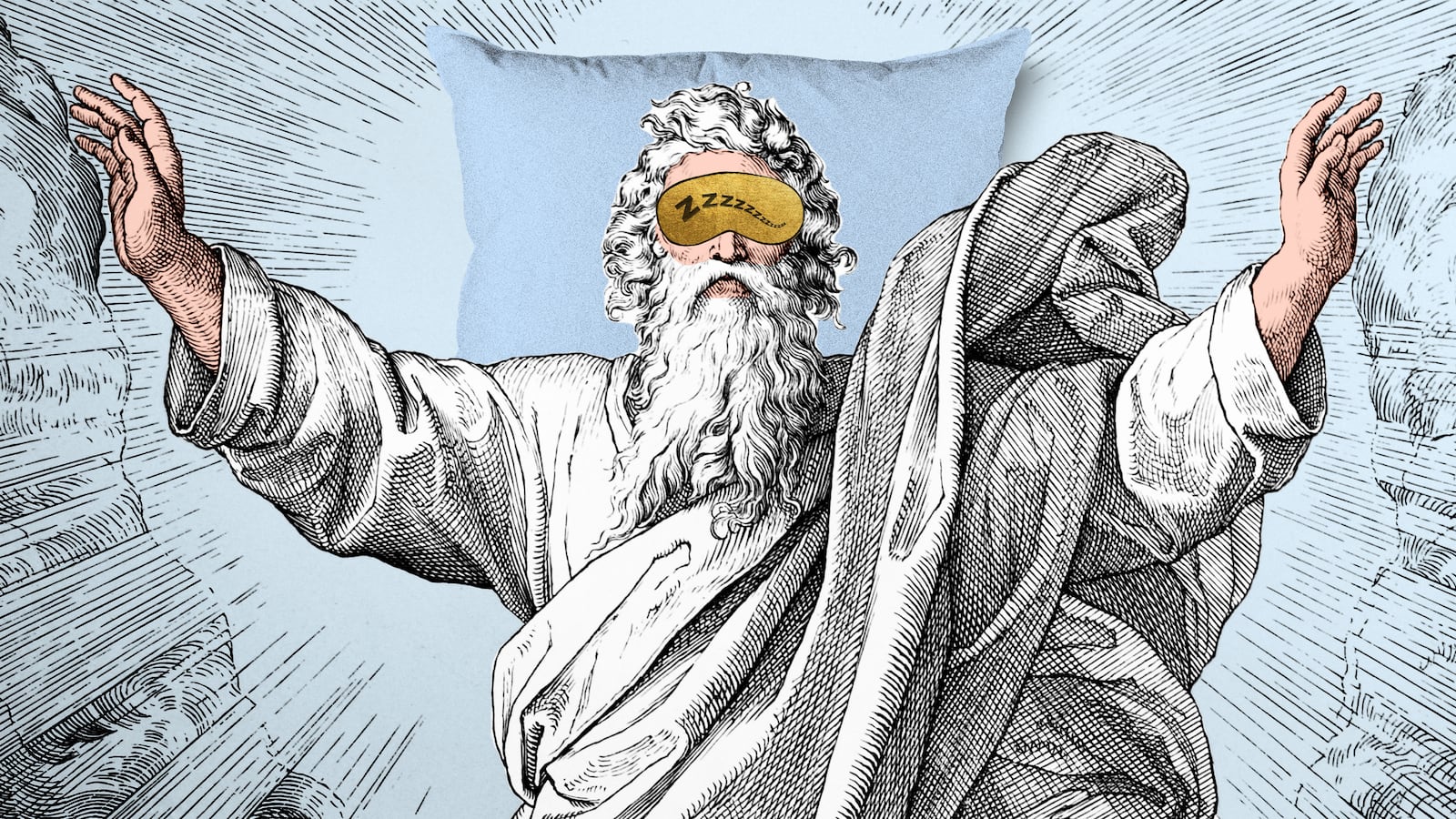On the seventh day, the book of Genesis says, after creating the universe from scratch and in the dark, God rested. This model of self-care is the whole reason that Jews observe the Sabbath and there are reduced trading hours in many countries on Sundays. God’s rest implies that, like humanity, God needs to rest. But the idea of God having a body that requires downtime would strike many contemporary Christians as absurd if not outrageously heretical. Omnipotence and naps are unlikely bedfellows. But a revolutionary new book by a distinguished Bible scholar argues that this is just one of the myriad ways that we need to take God’s body, and the Bible’s description of it, more seriously.
In her remarkable book God: An Anatomy, accomplished University of Exeter Professor of Hebrew Bible Francesca Stavrakopoulou takes us on a gripping yet rigorous journey through Biblical and Ancient Near Eastern ideas about God. In general, the gods of Southwestern Asia were lusty, muscular, passionate, and hungry. They had limbs, eyes, ears, and genitalia and they used those body parts to act and interact. Yahweh—the God of the Hebrew Bible—is no different. With the precision of a surgeon, she dissects and analyses God’s body from head to toe and, ahem, everywhere in between. Her arguments are not outlandish. As she meticulously shows descriptions of God’s body are everywhere.
Just when it comes to the question of sleep there is a multiplicity of evidence for divine burnout and rest. Beyond taking a personal day at the end of the first week, the Hebrew Bible refers to the sleeping arm of God. In Isaiah 51 the prophet begs God to wake up: “Awake, Awake, Put on Strength O Arm of the Lord.” In the aftermath of the Babylonian attack on Jerusalem in the sixth century BCE, one psalmist cried “Rouse yourself! Why do you sleep, O Yahweh? Awake! Do not cast us off forever!” While God was sleeping his—and thus his people’s—defenses were down, and the city had been ransacked. Though modern Christians don’t think about God sleeping they do use these passages. The verse from Isaiah, for example, decorates the cover of Bible journaling notebooks. We know about this idea we just don’t think about it.
That Yahweh took naps wasn’t that unusual. As Stavrakopoulou details in her book, deities in ancient Southwest Asia often retreated to their beds to get away from it all. According to an Ancient Near Eastern lament, the Sumerian deity Enlil was known to do this. After causing a famine, he barricaded himself in his Temple and pretended to be asleep. It’s passive aggressive, to be sure, but at least he had boundaries. Divine sleep could also index other rhythms in the world: the changing seasons, famine, drought, and other events were all a sign that God was taking time off for himself. Most commonly, however, it was a symptom or cause of divine neglect. When the god Baal fails to respond to the petitions of his prophets in the Bible, explains Stavrakopoulou, Elijah suggests that Baal simply fell asleep.
Of course, the idea of the God-who-naps, Stavrakopoulou told me, has caused no shortage of anxieties both ancient and modern. In the ancient world, she said, the concern was practical: “a deity who is off duty; a deity who’s stopped watching out for his worshippers, who’s stopped listening to them, [has] stopped intervening in their lives.” That’s a problem. For those influenced by Plato and more abstract understandings of transcendent deities, the concern is more philosophical. The idea of a God “who needs to rest” is suggestive of limits, human frailty, and even disability: “we get the impression of a god who’s over-exerted himself, a god who’s exhausted. It emphasizes the enormity and impressive ‘wonder’ of his creative work, but still leaves us with a god who’s not all-powerful but has his limits.” For lots of people, a God with limits isn’t much of a God.
This makes Christians nervous because the Christian God is supposed to be both omnipotent and completely unlike us. This is bound up in religious competition and claims the God of the Bible is the best of all deities. Stavrakopoulou shows us that Biblical texts try to distinguish between the uniquely powerful God of Judaism and Christianity and the false human-shaped but profoundly weak deities of other traditions. These foreign gods, she told me, “Are ‘disabled’ deities, who have eyes but do not see, hands but do not feel, noses but do not smell, etc. By contrast, God’s body works perfectly well.”
As a historian, Stavrakopoulou is interested in reading the Bible as a collection of ancient texts without getting caught up in or influenced by more recent religious commitments. Her goal, she told me, is to offer “a portrait of God in his ‘natural habitat’ in ancient southwest Asia during the first millennium BCE, when he was a god much like any other deity in the ancient world.” Her book is perfect for secular readers who previously dismissed the Bible as dull or irrelevant.
This doesn’t mean, however, that practicing Christians or observant Jews should steer clear of her book. Not only is it a riveting read it’s also a treasure trove of thoroughly researched material that can serve as a reference work for believers, pastors, and teachers. In fact, the ‘humanness’ of God is profoundly theologically important to the heirs of these traditions. After all, our bodies are created in the image of God. More important, Stavrakopoulou says, we can’t “quite do” without the human-like features of God. “Theologians tell us that we are in a relationship with God. But it’s difficult to have a relationship with the abstract. We’re a highly social species, and it’s by means of our bodies that we socialize – it’s how we forge and maintain relationships. Ultimately, God’s body rendered the divine more social.” The same is true today. Our religious connection with God isn’t just spiritual, it’s also embodied: Christians ask God to “hear” our prayers, to be “present” with us, and to “carry” us. These might be metaphors but they are also modes of interaction.
Moreover, recognizing the softer—some might say frailer— aspects of God’s body could help people who feel alienated by traditional portraits of the divine. For decades scholars interested in gender, disability, and race have criticized the hyper-masculine, ruggedly muscular, pale God of European Christianity. Stavrakopoulou challenges us to look behind the legacy of Renaissance artwork to what the Bible actually says. The God who needs rest and wheelchair (what else do you call a throne with wheels?) to move around in—as God does in Ezekiel and subsequent Jewish tradition—is more approachable to people with disabilities.
This God is just more relatable. For two thousand years Christians have tried to emulate Jesus, the incarnate deity. What would Jesus do and what God wants are one and the same. But often, living up to divine standards is hard. For those who are overworked and overburdened the God who takes naps may be easier to connect with than the God who judges.

